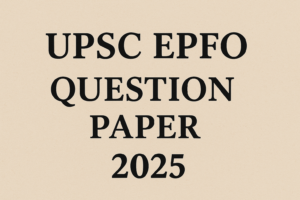Q20. Does tribal development in India centre around two axes, those of displacement and of rehabilitation? Give your opinion. (15 Marks, 250 Words)
| Approach |
| Introduce by defining a tribe as per the Imperial Gazetteer of India. In the body, first mention reasons why tribal development is centered around displacement, followed by tribal development centered around rehabilitation. Further address how holistic tribal development is centered beyond displacement and rehabilitation. Conclude by quoting Nobel Laureate Amartya Sen on the development of tribal communities. |
According to the Imperial Gazetteer of India, a tribe is defined as a collection of families united by a shared name, language, and territory. India, often described as a melting pot of diverse tribes and races, possesses the world’s second-largest tribal population after Africa. Historically, tribal development in India revolved around displacement and rehabilitation efforts, however the discourse is evolving towards a participatory, rights-based and culturally sensitive development.
Tribal development is centered around displacement
-
- Geographical isolation: The tribal communities live in isolation away from the main stream of human habitation which makes them vulnerable to health and education indicators.
- Eg: Sentinelese tribe of Andaman islands
- Ghettosiation: Large-scale industrialisation, dams, mining, and infrastructure projects have led to massive tribal displacement.
- Eg: Sardar Sarovar Dam Project displaced thousands of tribal families in MP, Maharashtra and Gujarat leading to social marginalisation and disorganisation.
- Cultural alienation: Implementation of the Wildlife Protection Act, 1972 and expansion of protected areas led to eviction of tribal communities from ancestral lands.
- Eg: Relocation of Baiga tribes from Kanha Tiger Reserve in Madhya Pradesh
- Structural inequality: Mining projects in states like Odisha and Jharkhand have uprooted tribal communities without ensuring social security.
- Eg: Displacement of Dongria Kondh tribe due to proposed bauxite mining in Niyamgiri Hills led to their loss of socio-economic autonomy.
- Resource dispossession: Among the tribal population have been declining due to alienation of land due to indebtedness, increase in tribal population and takeover of tribal lands for establishing industries.
- Eg: As per draft CAG report 2023, land held by tribals in Odisha is shrinking.
Tribal development is centered around rehabilitation
-
- Socio-economic subjugation: Tribals have served as bonded labourers in return for loans from money lenders.
- Eg: Sagri system in Rajasthan, Vetti system of Andhra Pradesh and Naukrinama in MP.
- Health exclusion: Greater level of consanguineous marriages lead to hereditary diseases and defects. There is an existence of high maternal mortality and infant mortality compared to national average.
- Eg: As per experts, Sickle cell anaemia prevalence high among tribals (2024)
- Sanitation crunch: Poor hygiene leads to increased vulnerability to diseases
- Eg: Kyasanur Forest Disease is a threat to forest tribes.
- Rising social pathologies: Rehabilitation schemes fail to restore social cohesion, kinship networks, and traditional community structures.
- Eg: Tribals displaced by Bodhghat Hydroelectric Project, Chhattisgarh faced difficulty in adapting to urban or semi-urban environments.
Tribal development beyond displacement and rehabilitation
- Education: Education is the cornerstone of social mobility and empowerment among tribal communities, enabling access to livelihood opportunities and socio-political participation.
- Eg: Eklavya Model Residential Schools (EMRS) provide quality education in remote tribal areas, focusing on retaining cultural identity while imparting modern skills.
- Sustainable livelihood: Tribal livelihoods historically depended on subsistence agriculture, shifting cultivation, and forest-based economies. Development now emphasises skill diversification for income security and resilience.
- Eg: TRIFED’s “Van Dhan Vikas Kendras” promote value addition of Minor Forest Produce (MFP), enhancing income through self-help groups.
- Health equity: High levels of malnutrition, maternal mortality, and communicable diseases among tribal populations necessitate focused healthcare interventions beyond displacement relief.
- Eg: Mobile medical units under the Adivasi Vikas Yojana bring healthcare to remote regions
- Cultural pluralism: Tribal communities possess distinct socio-cultural systems, rich oral traditions, and indigenous ecological knowledge that contribute to India’s cultural mosaic.
- Eg: UNESCO recognition of Kutiyattam and Warli art has elevated tribal art forms to global visibility.
- Community resource management: Tribes are traditional custodians of forests, practicing sustainable use of natural resources. Development initiatives now integrate eco-centric growth models.
- Eg: Forest Rights Act (FRA), 2006 empowers tribals with individual and community forest rights.
- Eg: Eco-tourism projects in Odisha and Chhattisgarh provide alternative income while preserving biodiversity.
- Gender justice: Tribal women often face intersectional disadvantages of gender, poverty, and geographic isolation, yet play crucial roles in household and community economies.
- Eg: Schemes like Vanbandhu Kalyan Yojana integrate gender concerns in livelihood and healthcare initiatives.
| Committee recommendations |
|
Therefore, instead of viewing tribal development in India through the narrow prism of displacement and rehabilitation, tribal development encompasses cultural preservation, socio-economic upliftment, participatory governance and overall inclusive growth. In the words of the Nobel Laureate Amartya Sen, “The development of tribal communities should not only be measured by economic standards but also by the extent to which they are able to preserve their culture and dignity”.

 UPSC EPFO Answer Key 2025 Out (Unofficia...
UPSC EPFO Answer Key 2025 Out (Unofficia...
 UPSC EPFO Question Paper 2025 PDF Downlo...
UPSC EPFO Question Paper 2025 PDF Downlo...
 UPSC EPFO Admit Card 2025 Out @ upsc.gov...
UPSC EPFO Admit Card 2025 Out @ upsc.gov...

























